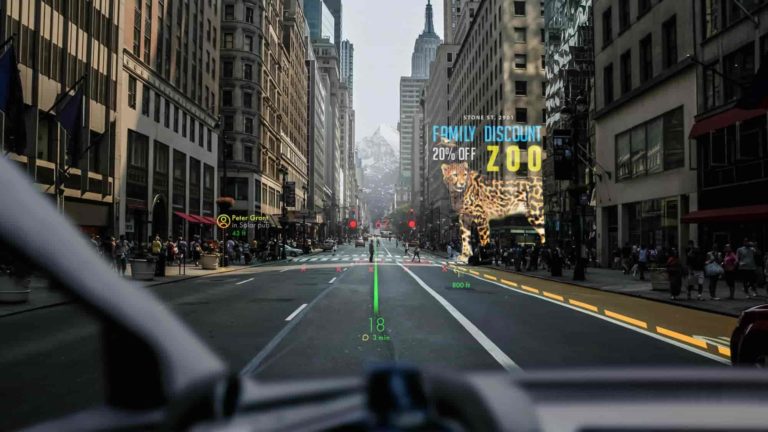
The AR cloud could drastically boost business growth with its collaborative and interactive capabilities. Organizations can leverage it internally and externally to drive profit, employee retention, and brand awareness.
What Is the AR Cloud?
First coined by AR thought leader and AWE co-founder Ori Inbar, the AR cloud is a continuous, shareable digital reflection of the real world. It contains various AR elements and is supplemented with online information. It’s different from typical augmented environments because it involves ongoing collaboration, transcending the conventional technology’s boundaries.
Simply put, it incorporates the best elements of the cloud into an interactive AR environment to create a collective experience. For example, someone could use it to view various coffee shops while they’re walking downtown. It would pull up menus, prices, reviews, and more as they pass each one. Additionally, it could give them visual directional cues to guide them to a specific one.
On the surface, the AR cloud is a real-time collection of moments, objects, experiences, and products that persist even when the original creator isn’t present. However, its use extends to content development and team communication because it creates an ever-present and reusable space. Businesses can leverage this capability internally or in mass production for consumers.
Why Should Businesses Adopt the AR Cloud?
According to a 2022 study, 75% of business professionals working for nonprofits have adopted cloud solutions to accommodate digital transformations. Cloud-based technology is at the forefront of innovation for many industries.
Businesses should consider adopting it because it could improve their daily operations. Its applications are endless since it’s a continuous space with object permanence. For example, an employee could visualize operational statistics with an augmented element, leave for a short vacation and return to find their project just as it was when they left.
Since the AR cloud relies on interactivity and shareability, they could even leave experiences or objects for other staff to engage with while they’re gone. It could enhance productivity or inspire connection among departments. Ultimately, it possesses many potential benefits.
Can the AR Cloud Drive Business Growth?
Businesses can use the AR cloud to drive business growth, considering it provides marketing, sales, perception and collaboration opportunities. Here are just a few…
1. Provides Advertising Space
Consumers have grown used to two-dimensional advertisements and know where to click to close or skip them. While most businesses still effectively advertise to their target demographics, the AR cloud presents a unique, revolutionary opportunity.
It provides a visual advertisement space for consumers to meaningfully engage with a brand. They interact with it instead of simply viewing it, boosting business growth. The presence of three-dimensional content in an AR environment is an innovative take on traditional marketing campaigns.
Consumers even benefit from this approach. They feel more confident in purchasing decisions when viewing objects in person because it sets their expectations. Since they see a product in “real life” with the AR cloud, they’d be more likely to buy and be more content with it.
2. Increases Brand Awareness
The AR cloud can contain augmented overlays on building fronts or specific areas, increasing brand awareness significantly. It offers unparalleled visibility compared to similar technologies — especially considering people can use it to navigate to commercial businesses.
Consumers often need incentives to branch away from their regular purchasing habits since they stick to what’s familiar. For example, they might not feel like repeatedly pulling up menu, price and review information for every restaurant in the vicinity, so augmented overlays on business fronts could convince them to deviate.
Some companies have also dabbled with product interactivity to increase brand awareness. For instance, Coca-Cola has experimented with embedded AR experiences, displaying variable narrative scenes whenever someone scans the QR code on one of its drinks. The move acts as a proof-of-concept for the approach.
3. Boosts Workplace Collaboration
Although most applications of the AR cloud revolve around consumer-driven content production or marketing, businesses can alternatively leverage it internally. It provides people with a collaborative, continuous space they can visit without needing one individual to host, so staff can connect whenever they want.
A shared AR environment provides employees with a fun, unique space to foster inclusivity and connection. Since increased collaboration can strengthen workplace morale and improve job satisfaction, utilizing the AR cloud could significantly boost business growth.
4. Offers Profitable Opportunities
Once the AR cloud expands and finds more consumers, businesses can use it to sell products and services. Their efforts would reach an entirely new demographic, considering the permanence and shareability of its augmented spaces can attract many new people.
The profitable opportunities of the AR cloud aren’t limited to marketing capabilities. Since it functions much like a mobile app, businesses can create multiplayer games, construct communities or offer real-time visual information about locations. The revenue comes from paid content or subscription-based services.
5. Enhances Customer Experience
The AR cloud stands to significantly improve the customer experience because it focuses on engaging with people instead of “at” them. Stronger interactions create meaningful connections, driving consistent brand growth.
It can turn something as mundane as a product display into an interactive experience, benefiting customers and the business. For example, one eyewear company leverages AR technology so potential customers can try glasses on virtually before checking out, lowering their return rates significantly.
Additionally, the AR cloud enhances the customer experience through increased availability and assistive technology. Google Lens utilizes the AR cloud for translation purposes, improving accessibility.
How Can Businesses Utilize the AR Cloud?
Businesses must only follow a few guidelines to utilize the AR cloud effectively. Ori Inbar — the person who coined the term — says organizations must meet three criteria to develop one:
- Scalable space: The space and elements must interact correctly with real-world geometry. They should be scalable and shareable.
- Instant localization: Users should immediately be able to interact with experiences and objects in real-time. They should function and look correct from any angle.
- Multiuser engagement: The experience should be able to run in real-time on multiple devices simultaneously.
There is more to the AR cloud than these three criteria, but they determine if the space fits into the category.
The Innovation of the AR Cloud
The AR cloud has incredible hidden potential regarding business growth, considering consumers and employees can benefit from it. While the technology isn’t widespread yet, it stands to be revolutionary.
 April Miller is a senior writer at ReHack Magazine and editorial contributor at AR Insider. She specializes in VR/AR, IoT, and business technology. See her work here and follow her @rehackmagazine.
April Miller is a senior writer at ReHack Magazine and editorial contributor at AR Insider. She specializes in VR/AR, IoT, and business technology. See her work here and follow her @rehackmagazine.






